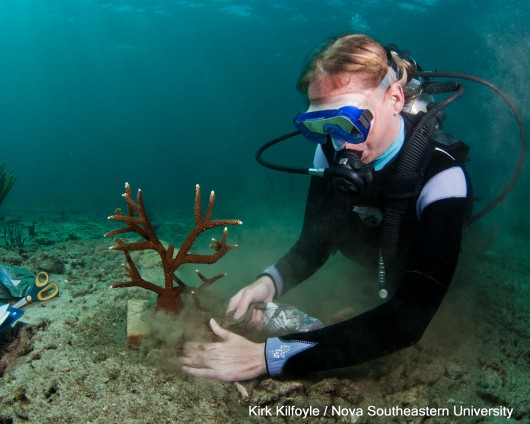NSU Newsroom
SharkBytes
Horizons
This version of NSU News has been archived as of February 28, 2019. To search through archived articles, visit nova.edu/search. To access the new version of NSU News, visit news.nova.edu.
This version of SharkBytes has been archived as of February 28, 2019. To search through archived articles, visit nova.edu/search. To access the new version of SharkBytes, visit sharkbytes.nova.edu.
Staghorn Coral Transplanted by Oceanographic Center Researchers to Broward County Reef

NSU Oceanographic Center Graduate Research Assistant Keri O’Neil cements coral fragment to the damaged coral reef
In a delicate operation at sea, healthy staghorn coral were transplanted on Feb. 17 to a threatened reef off the Broward County coast by researchers at Nova Southeastern University’sOceanographic Center and its internal National Coral Reef Institute (NCRI). “This is the northernmost location on the planet for transplanted staghorn corals,” said Abby Renegar, a researcher and doctoral student at Nova Southeastern University’s Oceanographic Center. “Staghorn corals previously have been transplanted in the Florida Keys, Southeast Florida, and other tropical locations around the world.”
This is the first time corals grown in an on-land nursery have been transplanted in Broward County. With coral reefs worldwide facing degradation due to pollution, overfishing, climate change and development, the transplant of healthy corals back to the reef is an important project for restoring damaged reefs. Coral reefs, which attract thousands of tourists annually, serve as nurseries where young fish hide from predators.
Florida accounts for 84 percent of all the coral reefs in the U.S. Those reef ecosystems bring in enough visitors a year to generate $6 billion into the economy and sustain 71,000 jobs. Growing under scientists’ watchful eyes for the past 18 months in a land-based nursery at the NSU Oceanographic Center, 28 basketball-sized staghorn corals will be carefully moved from the nursery and loaded onto a research vessel. The boat will transport them along with corals grown at the University of Florida’s Tropical Aquaculture Laboratory to a site three miles north of Port Everglades, where divers will cement them to their new home.
Usingfunding from a Florida State Wildlife Grant, Renegar along with NSU research assistant Keri O’Neil, will monitor the health of the newly transplanted coral each month for the next year and compare their growth with staghorn corals that were grown in a nursery on the reef.
“We’re looking for the factors that will help us develop strategies for growing these corals to restore reefs in Florida and around the world,” O’Neil said. “In land-based nurseries, we can control temperature and other conditions, which cannot be controlled on the reef.”
The transplantation site —- in 15 feet of water on the inner reef near the Broward County coast — once was home to a flourishing population of staghorn coral, but was largely lost to disease several years ago. Restoring genetically diverse colonies of staghorn coral to the site is expected to enhance the reef community and provide new habitat for reef creatures and juvenile fish.
“This outstanding research is consistent with NSUs mission of providing management- related research output on restoration of coral reefs,” said Richard E. Dodge, Ph.D., dean of the NSU’s Oceanographic Center. “This research aims to develop one of the tools in the manager’s toolbox to help address critical issues. Our scientists have contributed to transplanting over 1,000 corals offshore and this new initiative is critical to add a new dimension to the effort.”
NSU’s land-based coral nursery will triple in size this Spring with the opening of the 86,000-square-foot Center for Excellence for Coral Reef Ecosystem Science Research Facility. The $40-million Center was made possible thanks to a $15 million federal research grant —- the largest in NSU’s history —- from the National Institute of Standards and Technology.
As it will become America’s largest coral reef research center, the facility will be dedicated to coral reefs ecosystem research, while attracting top visiting scientists, post-doctoral fellows, and graduate students. It will have enough research space to grow more than 7,000 corals.
“It will be a transformational research center that will help NSU bridge the gap to the future of coral reef research,” said Bernhard Riegl, Ph.D., NSU OC professor.
David Gilliam Ph.D., a NSU Oceanographic Center assistant professor who heads up the Nova Southeastern University off-shore coral nursery program, said It’s vital to have both on-land and in-water nurseries to help better understand how to restore coral reefs. The new coral reef research center will do that.”
